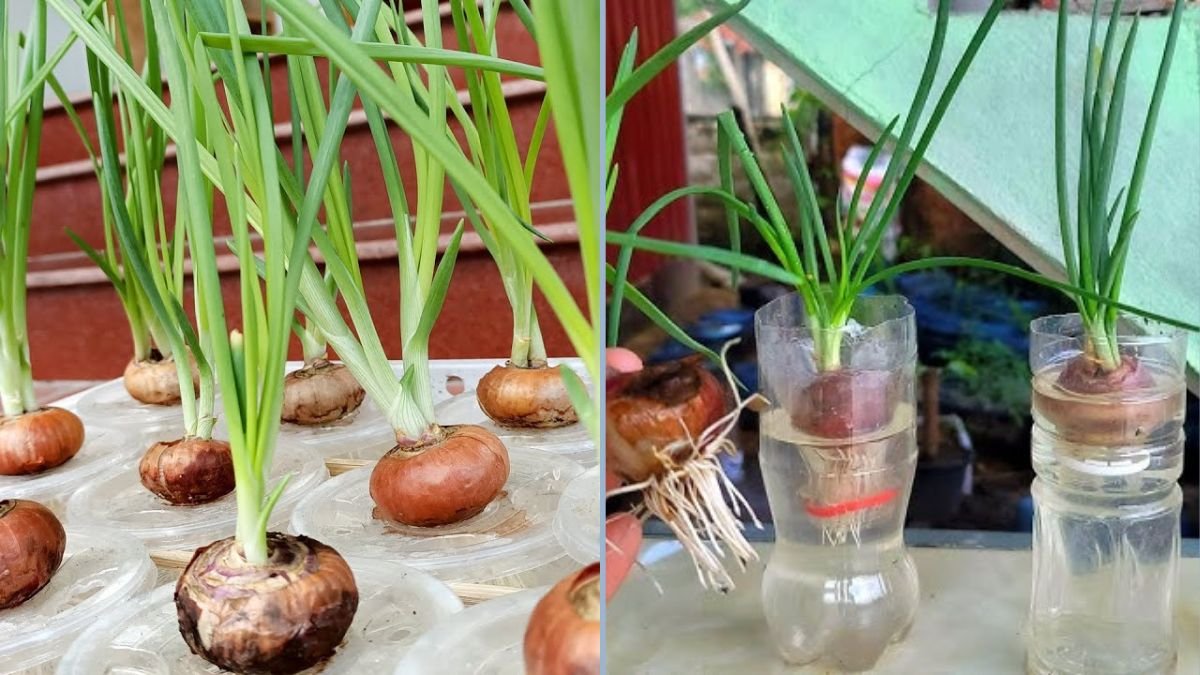Onions are a kitchen staple, adding flavor and aroma to countless dishes. But did you know that you can grow onions at home, even without a garden, using just a simple plastic bottle? Growing onions in bottles is a space-saving, beginner-friendly method that allows you to have a continuous supply of fresh onions and green shoots for cooking.
In this guide, we’ll show you step by step how to grow onions at home from onions in bottles, discuss the care required, and share tips to maximize growth and productivity. Whether you want fresh onion greens for salads or to grow full bulbs, this method is practical, fun, and sustainable.
Why Grow Onions in Bottles?
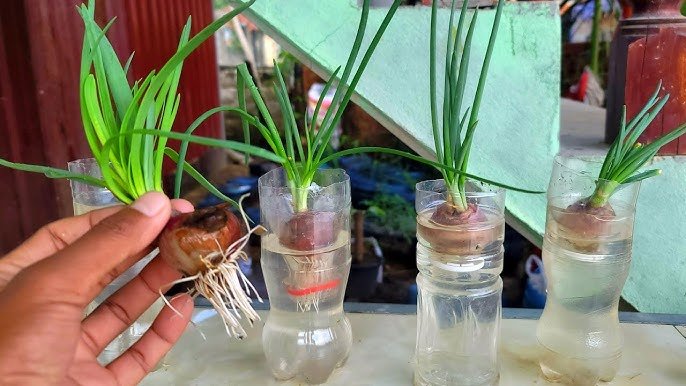
Growing onions in bottles offers several advantages:
- Space-Saving: Perfect for small apartments, balconies, and windowsills.
- Cost-Effective: Use existing onions instead of buying seeds or seedlings.
- Sustainable: Reuse plastic bottles and reduce kitchen waste.
- Beginner-Friendly: No advanced gardening knowledge is required.
- Quick Harvest: Onion greens grow quickly, and full bulbs can develop over time.
This method is ideal for urban gardeners, beginners, and anyone looking to grow fresh, healthy onions at home.
Materials You’ll Need
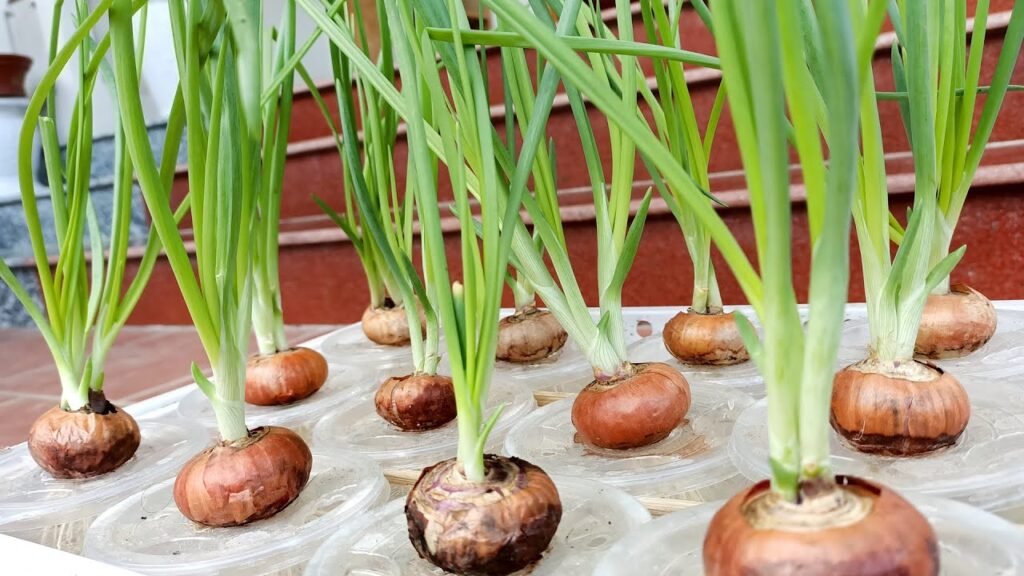
Before getting started, gather the following:
- A plastic bottle (1.5–2 liters works best)
- A sharp knife or scissors
- Onion bulbs (medium-sized, firm, and healthy)
- Potting soil or a mix of compost and soil
- Water
- Optional: Fertilizer for better growth
Using basic household items, you can create a productive mini-onion garden with minimal investment.
Step-by-Step Guide to Growing Onions in Bottles
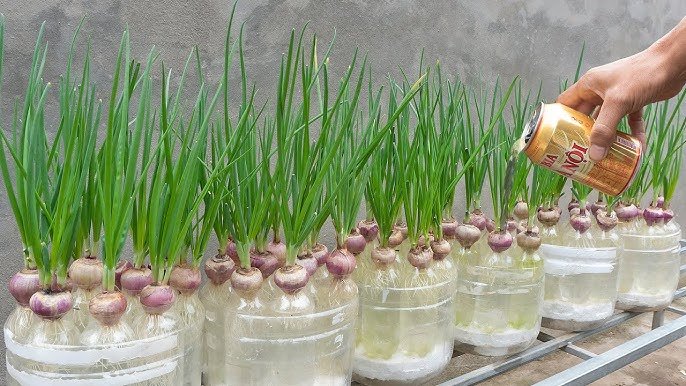
Step 1: Prepare the Bottle
Start by thoroughly cleaning the plastic bottle. Remove any labels and residue.
Cut the bottle horizontally about one-third from the top. The bottom portion will hold the soil and onion, while the top part can be used as a cover or funnel for watering.
Next, make a few small drainage holes at the bottom. This prevents waterlogging, which can cause onion bulbs to rot.
Step 2: Prepare the Soil
Onions prefer well-draining, nutrient-rich soil. Fill the bottle with a mixture of:
- Garden soil or potting mix
- Compost or well-rotted organic matter
Leave about an inch of space from the top to make watering easier. Avoid compacting the soil too much—the roots need loose soil to grow and expand.
Step 3: Prepare the Onion
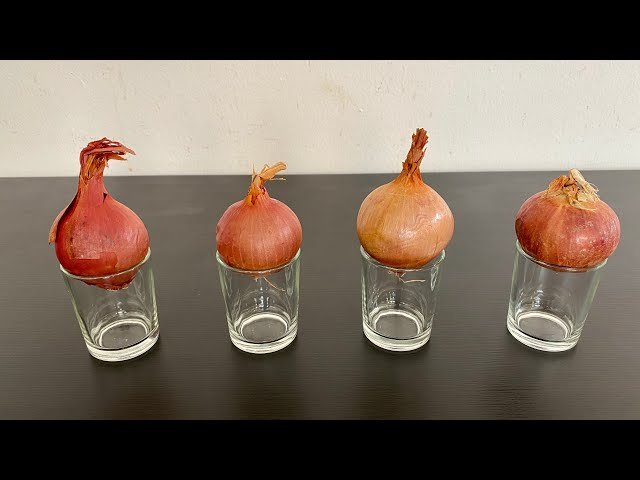
You can grow onions from:
- Whole bulbs: Use firm, healthy onions. Cut the base slightly if needed to expose the root.
- Cut onions: Use the bottom portion (root end) of an onion, which will sprout new shoots.
Make sure your onion has a healthy base, as this is where new roots and greens will develop.
Step 4: Plant the Onion
Place the onion base into the soil with the root side down. Cover it lightly with soil, leaving the top portion of the onion exposed.
Tip: If planting multiple onions in one bottle, space them at least 2–3 inches apart to prevent overcrowding.
Step 5: Watering
Water the soil thoroughly immediately after planting. Keep the soil consistently moist but avoid waterlogging, as excess water can rot the bulb.
Water once daily or every other day depending on the weather and indoor conditions. If the topsoil feels dry, it’s time to water.
Step 6: Provide Sunlight
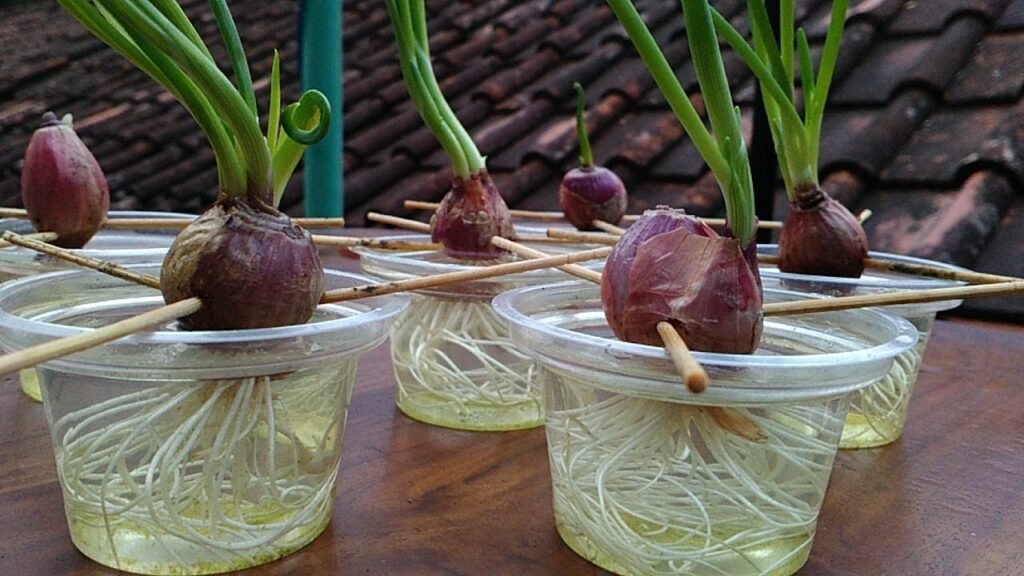
Onions need 4–6 hours of direct or indirect sunlight each day. Place your bottle near a sunny window, balcony, or outdoor area with good light.
For indoor setups with limited sunlight, consider using an LED grow light to ensure your onions grow strong and healthy.
Step 7: Fertilizing for Growth
While onions can grow in plain soil, adding organic fertilizer boosts growth. Use compost tea or diluted liquid fertilizer every 2–3 weeks to help the plant develop healthy roots and long green shoots.
Be careful not to over-fertilize, as too much nitrogen can lead to lots of leaves but smaller bulbs.
Pruning and Maintenance
Pruning is optional but can encourage faster, healthier growth:
- Trim yellow or damaged leaves: Helps prevent disease and promotes new growth.
- Pinch tips for bushier greens: This encourages the plant to produce more shoots.
Maintain airflow around the bottles to prevent mold or fungal growth. Regular maintenance ensures productive onion plants.
Harvesting Your Onions
Onions grown in bottles can be harvested in two ways:
- Onion Greens:
Harvest the tender green shoots for salads, stir-fries, and garnishes. Cut leaves about 1–2 inches from the base, leaving the rest to regrow. - Full Bulbs:
Wait until the onion bulbs are fully developed, typically 90–120 days. Harvest by gently removing the bulb from the soil. If desired, leave a few bulbs to sprout again for a second harvest.
Tip: Regularly harvesting greens encourages more growth and keeps your plant productive.
Extra Tips for Successful Onion Growth
- Choose healthy onions: Fresh, firm onions sprout faster and grow stronger.
- Keep soil loose: Compacted soil restricts root growth and reduces bulb size.
- Avoid overwatering: Moist soil is ideal, but too much water can cause rot.
- Provide enough sunlight: Onions need good light for green shoots and bulb development.
- Prune regularly: Removing damaged leaves keeps plants healthy and encourages regrowth.
By following these tips, you’ll enjoy lush onion greens and even full bulbs right from your bottles!
Benefits of Growing Onions in Bottles
- Cost-Effective: Grow your own onions instead of buying new ones from the store.
- Eco-Friendly: Repurpose plastic bottles and reduce kitchen waste.
- Space-Saving: Perfect for apartments, balconies, or small spaces.
- Quick Harvest: Onion greens grow quickly, providing a continuous supply.
- Educational and Fun: Great for beginners and kids to learn about plant growth.
This method transforms your kitchen scraps into a productive mini-garden.
Health Benefits of Onions
Onions aren’t just flavorful—they’re packed with nutrients:
- Vitamin C: Supports immunity and skin health.
- Antioxidants: Help combat inflammation and oxidative stress.
- Sulfur Compounds: Promote heart health and may lower cholesterol.
- Fiber: Aids digestion and maintains gut health.
By growing onions at home, you get fresh, pesticide-free, nutrient-rich produce.
Conclusion
Growing onions at home in bottles is simple, sustainable, and perfect for beginners. With just a few materials—plastic bottles, soil, water, and healthy onions—you can cultivate a continuous supply of green shoots and even full bulbs.
This method saves money, reduces waste, and allows you to enjoy fresh, home-grown onions anytime. Whether you want to garnish your meals with fresh greens or grow full onions for cooking, bottle gardening is a practical and rewarding solution.
Start with a few onions today, follow these simple steps, and in a few weeks, you’ll be harvesting fresh, crisp greens straight from your mini home garden. Your kitchen will never run out of onions again!
